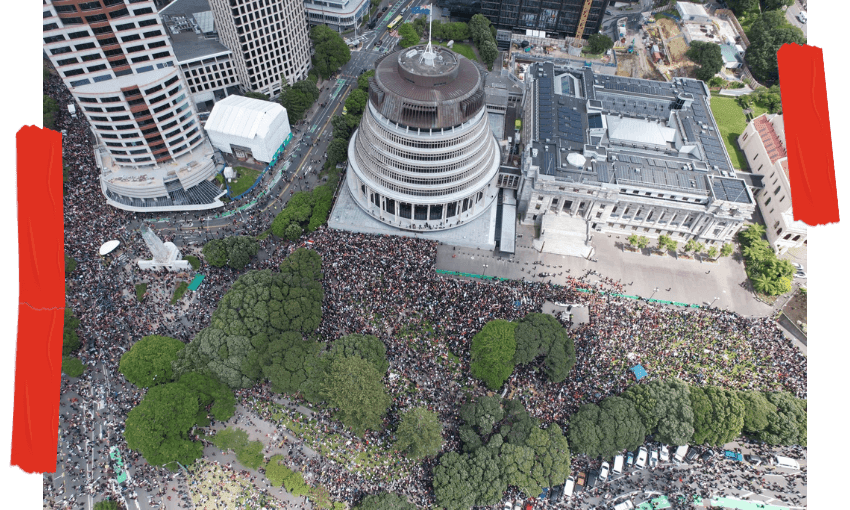Media estimates of the crowd size ranged from 17,000 to 100,000+, but one thing we can say for sure — it was bloody massive.
Thirty-five thousand people. That’s the crowd size police initially estimated for the final leg of the Hīkoi mō te Tiriti, the nine-day march in protest of a number of government actions, particularly the Treaty Principles Bill, which passed its first reading on Thursday (though National has vowed to not vote for it at second reading). The 35,000 estimate was repeated by most media outlets.
But the consensus among journalists at parliament on Tuesday, veterans of countless protests on the front lawn, was that 35,000 is likely an underestimate. RNZ initially reported 17,000, which is undoubtedly too low. Waatea News, on the other hand, claimed 100,000, a number probably too high. Later in the day, police upped its estimate to 42,000. Experienced protest crowd counter Grace Millar put the number at 50,500 people who “went past the end of Lambton Quay… Not including people at parliament, cenotaph… or those linking the streets“.
Of course, protests are about so much more than just crowd size. Yet everyone wants to know the number. Police and media typically use Jacobs’ Method, which divides the area occupied by a crowd into sections, counts the people in one section, and multiplies by the number of sections. It’s inexact but gives you a ballpark figure. But even if we could work out the exact number, it’s hard to express what that means on the ground. A crowd of 50,000 at Eden Park is incomparable to a crowd of the same size marching towards parliament.
At 9am yesterday, before the hīkoi began, I walked past parliament, where a couple of thousand people were already gathered on the grounds. It would be several hours before the rest of the crowd joined them.
The traditional starting point for protests in Wellington is Te Ngākau Civic Square, but in this case the hīkoi organisers chose Waitangi Park. The name felt apt, but more importantly, the park is much larger – the size of six rugby fields. There’s no way Civic Square could have held this many people. Waitangi Park is used for the main stage of Homegrown, which draws an annual crowd of around 25,000 people. The crowd at the hīkoi made Homegrown look like a school production.
The crowd that gathered at the park spilled out on all sides – into Cable Street, New World and the Te Papa car park. It took me 17 minutes of patiently squeezing past people to reach the edge of the grass. The sheer volume overwhelmed the mobile network; there was no signal at Waitangi Park, and reception remained patchy throughout the hīkoi.
The hīkoi started eastwards towards Kent Terrace, then looped around Courtenay Place before heading down the Golden Mile to parliament – a total distance of 3km. Thousands poured out of the park, barely seeming to make a dent in the mass that remained. The performers on stage played Katchafire covers to a sea of waving flags. I met Mitai Paraone-Kawiti (Ngā Puhi), who had attended the 1975 Māori land march as a 15-year-old with his aunty, Dame Whina Cooper. That hīkoi drew a crowd of 5,000.
After waiting 45 minutes for the last of the crowd to start moving, I followed along, just ahead of the four horsemen at the rear. By then, the front of the march had reached Willis Street, 1.4km away. The line kept stretching as the front moved faster than the rear. When the first marchers arrived at parliament, the tail was still on Courtenay Place approaching the Taranaki Street intersection, 2.2km back.
At all points, the street and footpaths were packed with bodies, making it difficult to move. Dairies and takeaway shops along the route did a roaring trade. Aid stations were set up along the way, offering sunblock, water bottles, bags of chips and muesli bars.
As the back of the hīkoi turned into Lambton Quay, whispers began: “We’re not going to fit into parliament grounds, are we?” No, we weren’t, not even close. As we passed Public Trust Hall on Lambton Quay, the march slowed to a standstill. There was no more room to advance. We were 400 metres from parliament’s forecourt, where speakers had already begun addressing the crowd. People started splitting off down side streets, trying to find a route to get closer to the action.
The edge of the crowd on Whitmore Street. Image: Joel MacManus.I walked through the crowd and up Bowen Street – where many people had sat down to eat without a view of the forecourt – to reach parliament’s back entrance and photograph the scene from the Beehive balcony. Even from that height, the scale was impossible to capture.
There are a few contenders for New Zealand’s largest single-location protest: the 2010 Auckland rally against mining on conservation land, this year’s Dunedin hospital protest, the anti-Vietnam War march in 1971, and the 2019 School Strike for Climate in Wellington each drew crowds estimated at 30,000 to 40,000 people. The organisers of the Auckland school strike claimed to have 80,000 attendees, though those numbers are hard to prove. I watched the School Strike for Climate march to parliament in 2019, which reported a turnout of 40,000. To me, the hīkoi crowd looked at least 50% bigger.
We’ll never know the exact number at the hīkoi, but it was enormous. It was undoubtedly the most people who have ever marched on parliament. Was it New Zealand’s largest-ever protest? It’s impossible to say for sure, but yeah, probably.

